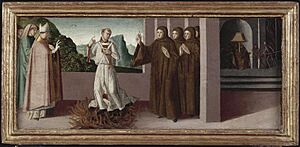Peter Igneus facts for kids
Pietro Igneo (who passed away on November 11, 1089) was an Italian monk. He belonged to a branch of the Benedictine order called the Vallombrosians. He also became a very important leader in the Catholic Church, serving as a cardinal. He was known as the Cardinal-Bishop of Albano. People sometimes say he was part of the Aldobrandini family, but this isn't proven by old records.
Pietro Igneo was officially recognized as "Blessed" by the Church on March 4, 1673.
Quick facts for kids Peter Igneus |
|
|---|---|
| Cardinal-Bishop of Albano | |

Peter Igneus over the fire - Marco Palmezzano.
|
|
| Church | Roman Catholic Church |
| Appointed | 1072 |
| Reign ended | 11 November 1089 |
| Successor | Nicholas Breakspear |
| Orders | |
| Created Cardinal | 1072 |
| Rank | Cardinal-Bishop |
| Personal details | |
| Birth name | Pietro Igneo |
| Born | Florence, Tuscan Margrave |
| Died | 11 November 1089 Albano, Rome, Papal States |
| Sainthood | |
| Feast day | 8 February |
| Venerated in | Roman Catholic Church |
| Beatified | 4 March 1673 Saint Peter's Basilica, Papal States by Pope Clement X |
| Attributes |
|
Contents
The Story of Peter Igneus
Early Life and Family
Pietro Igneo was born into a noble family in Florence. He was related to a famous monk named John Gualbert. He was also the uncle of Bernardo degli Uberti, who later became a cardinal himself. Pietro had at least one brother or sister.
In the year 1018, Pietro decided to become a monk. He joined the Order of Saint Benedict.
The Amazing Trial by Fire
A bishop named Pietro Mezzobarbo was accused of buying his church position. This was a serious charge called simony. Bishop Mezzobarbo strongly denied it and had many powerful friends who supported him. This accusation caused a lot of trouble and anger in Florence.
The Vallombrosian monks were the main people accusing the bishop. The people of Florence demanded proof. So, they decided to use a "judgment of God," also known as a trial by fire, to settle the matter.
John Gualbert, who was Pietro's relative and the head of the monks, chose Pietro to undergo this dangerous test. On February 23, 1068, Pietro walked through fire. He succeeded! Because of this amazing event, he was called "Igneo," which means "fire-tried." After Pietro's success, the bishop confessed to the charges.
Becoming a Church Leader
Soon after the trial by fire, Pietro Igneo became the abbot of a monastery called San Salvatore in Fucecchio. He led this monastery until 1081.
In 1072, he was chosen to be a cardinal. Pope Alexander II officially named him the Cardinal-Bishop of Albano. Pietro Igneo attended the dedication of a church in Albano in October 1072. He also dedicated another church in Rubbicana on February 7, 1077.
Working with Popes
Pietro Igneo worked closely with Pope Gregory VII. They worked together to stop simony (buying church positions) and to improve how the church was run. Pope Gregory VII sent Pietro on several important missions.
In 1079, Pietro went to Germany as a special representative of the Pope. His job was to help make peace between Emperor Henry IV and Rudolf of Swabia. Later, in 1084, when the Emperor was again excommunicated (kicked out of the church), Pietro was sent to France. He was one of two special messengers sent by Pope Gregory VII to announce this decision.
Pietro Igneo is mentioned in an official document from Pope Urban II on July 8, 1089. He was last seen at the Pope's court in September 1089.
His Final Years
In 1087, Pietro Igneo helped to consecrate, or officially bless, the new Pope Victor III. He also took part in the elections for new popes in 1086 and 1088.
Pietro Igneo passed away on November 11, 1089.

